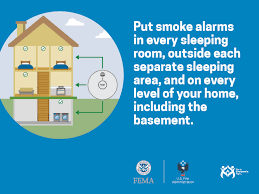
Giving You Time to Get Out
Smoke alarms save lives. Almost two-thirds of home fire deaths resulted from fires in homes with no smoke alarms or no working smoke alarms. When there is a fire, smoke spreads fast and you need smoke alarms to give you time to get out.
Safety Tips
- Test alarms at least monthly by pushing the test button.
- Smoke rises, so install smoke alarms following the manufacturer's instructions high on a wall or on a ceiling.
- Save manufacturer's instructions for testing and maintenance.
- Replace batteries in all smoke alarms at least once a year. If an alarm “chirps,” it is warning you that the battery is low. Replace the battery right away.
- Replace all smoke alarms, including alarms that use 10-year batteries and hard-wired alarms, when they are 10 years old or sooner if they do not respond properly.
- Be sure the smoke alarm has the label of a recognized testing laboratory.
- Alarms that are hard-wired (and include battery backup) must be installed by a qualified electrician.
- If cooking fumes or steam sets off nuisance alarms, replace the alarm with an alarm that has a "hush" button. A "hush" button will reduce the alarm’s sensitivity for a short period of time.
- An ionization alarm with a hush button or a photoelectric alarm should be used if the alarm is within 20 feet of a cooking appliance.
- Smoke alarms that include a recordable voice announcement in addition to the usual alarm sound may be helpful in waking children through the use of a familiar voice.
- Smoke alarms are available for people who are deaf or hard of hearing. These devices use strobe lights. Vibration devices can be added to these alarms
- Smoke alarms are an important part of a home fire escape plan.
